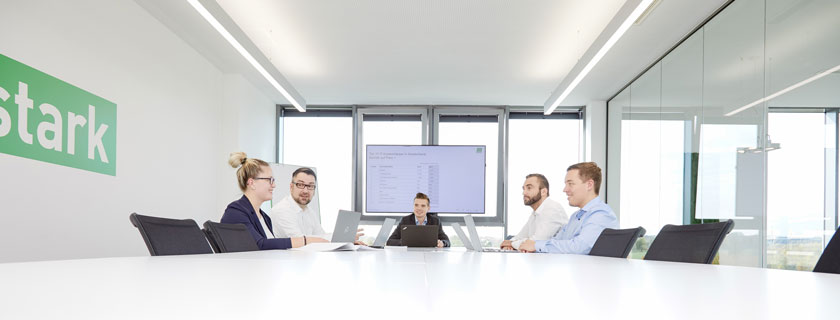Hybrid working – Why the time has come to modernise meeting rooms.
by Florian Vees
Look at the meeting rooms in many companies and you’ll be forgiven for failing to notice any differences compared to five or ten years ago. That’s an issue because they way we work has changed so much and hybrid meetings are here to stay. These days, some people are on-site in the meeting room while others dial in from elsewhere, so if the tech isn’t up to the job of facilitating location-agnostic collaboration, productive hybrid meetings are impossible.
Written by
Hybrid meetings require us to change our mindsets.
We’ve all taken part in meetings virtually and found ourselves sat on the sidelines, while those actually in the meeting room run the show. Virtual participants are often nothing more than an audience, contributing little—meaning essential input tends to go unheard. All the more important then that businesses offer hybrid meetings that open the door to numerous opportunities for modern collaboration among teams.

Interaction not detachment.
Tools such as intuitive whiteboards on which employees can quickly sketch out their ideas are ideal for promoting collaboration, but virtual meetings are usually perceived as distant and passive. However, when a meeting room is equipped with several cameras and smart speaker tracking, the virtual participants can see everyone in the room and the person speaking is always in focus optimising dynamics, ensuring the meeting feels more natural and creating a feeling of closeness.
Modern technology such as cameras and audio equipment is only one part of the story. The other is having the right software that facilitates working together on documents, detailing results and promoting creative collaboration. After all, easy access to tools and programs determines whether these new opportunities are taken advantage of or not.
Individual concepts for various needs.
“We need better cameras in our meeting rooms.” This is one of the most common requests we get from businesses, but when it comes to defining what the perfect hybrid meeting looks like, we have to think about more than just the equipment. When designing a holistic and tailored concept, it’s crucial to know how employees use the rooms, i.e. how many people take part in the meetings and what form they are held in. It’s also essential to understand whether meeting rooms are used by employees of various departments such as controlling, marketing or production as differing working styles demand meeting room equipment be tweaked.
When evaluating the needs of our customers vis-à-vis hybrid meetings, we therefore have to consider the answers to a range of questions. Are these rooms for classic meetings or is it important to enable a more creative exchange? What is the layout of the room? Who works in the surrounding offices? Who will be using the rooms? What requirements do these employees have of their meetings? Once we have the answers, we can develop a custom concept for a specific room or for several types of room within a company, and support our customers in teaching their employees to leverage the rooms and technology to get the best out of them.
Guiding principles are the name of the game.
We know from practical experience that it’s helpful for businesses to provide meeting rules. Individual teams develop specific guiding principles in order to be able to work together efficiently by defining different types of meetings such as quick sprint calls, creative collaboration and more classic meetings. They also determine how long a meeting should last and if it should take place virtually, in-person or hybrid. Other guidelines relate to meeting objectives and govern how to enable every hybrid meeting participant an equal opportunity to speak and include them effectively.
In short, successful hybrid and flexible working requires a basic foundation. Modern technologies, hybrid working corporate cultures and employee motivation are all essential for achieving successful and flexible working and we at Bechtle can offer so much more than just provide the right tech. We develop custom room concepts, always have an eye on employee needs and can offer support during the change process to get the absolute best out of hybrid working.
